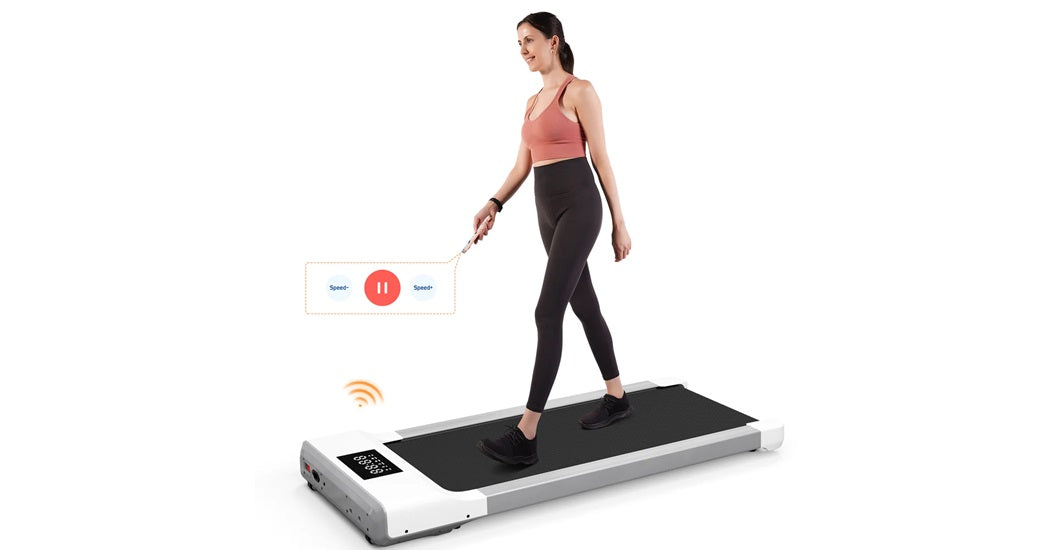In the pursuit of a healthier lifestyle, the role of physical activity cannot be overstated, and among the myriad options available, treadmill workouts stand out as a versatile and accessible means of exercise. The importance of incorporating treadmill workouts into one's fitness routine goes beyond the simple act of running or walking in place; it serves as a gateway to achieving a spectrum of health and wellness goals.
Why Treadmill Workouts Are Important?
Treadmill workouts offer a controlled environment where individuals can engage in cardiovascular exercise, making them particularly valuable for enhancing heart health and promoting overall fitness. The treadmill's adaptability caters to users of varying fitness levels, allowing beginners to gradually build stamina and providing a challenging platform for seasoned athletes to fine-tune their endurance. Moreover, the structured nature of treadmill workouts facilitates goal-oriented training, making it an effective tool for weight management, cardiovascular health, and overall well-being.
Factors Influencing Treadmill Workout Duration
Fitness Level:
Beginners vs. Experienced Individuals:
- Novice treadmill users may require shorter sessions initially to acclimate to the intensity and duration of the exercise.
- Gradual progression is essential to avoid overexertion and potential injuries.
- Experienced individuals, familiar with treadmill workouts, may engage in longer sessions with increased intensity, challenging their cardiovascular and muscular endurance.
Specific Goals:
Weight Loss:
- Longer durations may be beneficial for weight loss, as sustained aerobic activity helps burn calories and fat.
- Incorporating interval training within the workout can enhance calorie expenditure and metabolic rate.
- Consistency and duration are key factors in achieving and maintaining weight loss goals.
Endurance Building:
- Individuals aiming to enhance endurance should focus on gradually increasing treadmill workout durations over time.
- Incorporating a mix of steady-state cardio and interval training can improve aerobic capacity and stamina.
- Longer, moderate-intensity sessions contribute to improved muscular and cardiovascular endurance.
- For cardiovascular health, the American College of Sports Medicine (ACSM) recommends a minimum of 150 minutes of moderate-intensity exercise per week.
- Treadmill workouts of varying durations can contribute to meeting these guidelines, promoting heart health, and reducing the risk of cardiovascular diseases.
- Interval training, with periods of higher intensity, can provide additional cardiovascular benefits within a shorter timeframe.
Understanding the relationship between individual fitness levels and specific goals is crucial in determining the optimal treadmill workout duration. Tailoring the duration based on these factors ensures that individuals can maximize the benefits of their treadmill workouts while working towards their unique fitness objectives.

General Guidelines for Treadmill Workouts
American College of Sports Medicine (ACSM) Recommendations:
Duration for Health Benefits:
- The ACSM recommends at least 150 minutes of moderate-intensity aerobic exercise per week for overall health benefits.
- Treadmill workouts can be structured in various durations, such as 30 minutes on most days of the week, to meet these guidelines.
- Accumulating exercise in bouts of at least 10 minutes is considered effective for health benefits.
Frequency of Treadmill Workouts:
- To promote cardiovascular health, the ACSM suggests engaging in moderate-intensity exercise on most, preferably all, days of the week.
- Treadmill sessions can be distributed throughout the week to achieve the recommended weekly exercise duration.
- Individuals with specific fitness goals may adjust the frequency based on their training objectives and overall schedule.
Warm-up and Cool-down Considerations:
Importance of Dynamic Warm-up:
- A dynamic warm-up before treadmill workouts is crucial to prepare the muscles, joints, and cardiovascular system for the upcoming activity.
- Dynamic movements such as leg swings, high knees, and lunges help increase blood flow, enhance flexibility, and activate key muscle groups.
- A proper warm-up reduces the risk of injury and improves overall workout performance.
Benefits of a Proper Cool-down:
- A cool-down period allows the heart rate to gradually return to its resting state, preventing abrupt drops in blood pressure.
- Incorporating light aerobic activity, such as slow walking, into the cool-down helps remove metabolic byproducts and reduces muscle soreness.
- Stretching during the cool-down promotes flexibility and may aid in preventing muscle tightness or injury over time.
Adhering to the ACSM recommendations and incorporating effective warm-up and cool-down practices helps individuals can derive maximum benefits from their treadmill workouts while minimizing the risk of injuries and optimizing overall fitness outcomes.

Simulate Treadmill Workouts
Beginner's Workout (30 minutes):
Warm-up (5 minutes):
- Start with a slow walk at a comfortable pace to gradually increase heart rate and warm up muscles.
- Incorporate dynamic stretches such as leg swings and arm circles to promote flexibility.
Alternating Brisk Walk and Jogging Intervals:
- Begin with a brisk walk for 2 minutes to elevate your heart rate.
- Transition to a light jog for 1-2 minutes, maintaining a pace suitable for the individual's fitness level.
- Repeat the alternating brisk walk and jogging intervals throughout the workout.
- Gradually increase the intensity of jogging intervals as fitness improves.
Cool-down (5 minutes):
- Conclude the workout with a slow-paced walk to gradually lower your heart rate.
- Perform static stretches targeting major muscle groups, holding each stretch for 15-30 seconds.
- Focus on stretching the calves, hamstrings, quadriceps, and hip flexors.

Advanced HIIT Workout (20 minutes):
Warm-up (5 minutes):
- Begin with a moderate-paced walk or light jog to prepare the body for the upcoming high-intensity intervals.
- Include dynamic movements like high knees and leg swings to activate muscles.
Intervals of Sprinting and Recovery:
- Sprint at maximum effort for 30 seconds, pushing the limits of speed.
- Recover with a slow-paced walk or light jog for 1 minute to allow the heart rate to lower.
- Repeat the sprint and recovery intervals for a total of 8-10 cycles.
- Adjust sprint duration or recovery intensity based on individual fitness levels.
Cool-down (5 minutes):
- Conclude the workout with a slow walk to gradually bring the heart rate down.
- Perform static stretches targeting the major muscle groups, holding each stretch for 15-30 seconds.
- Focus on stretching the quadriceps, hamstrings, and hip flexors, paying attention to any areas of tightness.
Treadmill Workouts Tips
Recognizing Signs of Fatigue:
Decreased Performance:
- Pay attention to a noticeable decline in performance during the workout, such as a significant drop in pace or inability to maintain the usual intensity.
Breathlessness:
- If the workout feels excessively challenging, and you're struggling to catch your breath, it may be a sign of fatigue.
- Difficulty in maintaining a conversation during exercise can be an indicator.
Muscle Weakness or Trembling:
- Notice any unusual weakness or trembling in the muscles, which may indicate muscle fatigue.
- Difficulty controlling movements or maintaining proper form can be signs of muscular exhaustion.
Mental Fatigue:
- Fatigue isn't only physical; mental exhaustion can also impact your workout. If you find it hard to concentrate or feel unusually irritable, it's time to consider a break.
Avoiding Overtraining and Injuries:
Gradual Progression:
- Avoid sudden increases in workout intensity or duration. Gradual progression allows the body to adapt and reduces the risk of overtraining.
- Follow the principle of progressive overload, gradually increasing the workload over time.
Adequate Rest and Recovery:
- Ensure sufficient rest days between intense workouts to allow the body to recover.
- Incorporate restorative practices such as sleep, hydration, and proper nutrition to support recovery.
Listen to Pain Signals:
- Distinguish between normal discomfort and pain. Pain that is sharp, localized, or persists should not be ignored.
- Address any persistent discomfort promptly to prevent the development of chronic issues.
Cross-Train and Diversify Workouts:
- Avoid overworking specific muscle groups by incorporating cross-training activities.
- Diversifying workouts helps prevent overuse injuries and keeps the body balanced.
Regular Assessments:
- Periodically assess your overall well-being and adjust your workout routine accordingly.
- If signs of overtraining persist, consider consulting with a fitness professional or healthcare provider.

Conclusion
In the pursuit of optimal health and fitness, the question of "How long is a good workout on a treadmill?" finds its answer in the delicate balance between individual goals, fitness levels, and time constraints. Treadmill workouts, with their adaptability and accessibility, offer a versatile platform for achieving a spectrum of objectives, from weight loss and endurance building to cardiovascular health.
The guidelines set forth by reputable sources like the American College of Sports Medicine (ACSM) provide a foundation for structuring effective treadmill workouts. Understanding the importance of duration, frequency, warm-up, and cool-down elements lays the groundwork for a well-rounded and sustainable exercise routine.
For beginners, a gradual approach that includes a balanced mix of brisk walking and jogging, coupled with appropriate warm-up and cool-down routines, serves as a stepping stone toward improved fitness. On the other end of the spectrum, advanced High-Intensity Interval Training (HIIT) workouts provide an efficient means of achieving cardiovascular benefits within a condensed timeframe.






Leave a comment
All comments are moderated before being published.
This site is protected by hCaptcha and the hCaptcha Privacy Policy and Terms of Service apply.